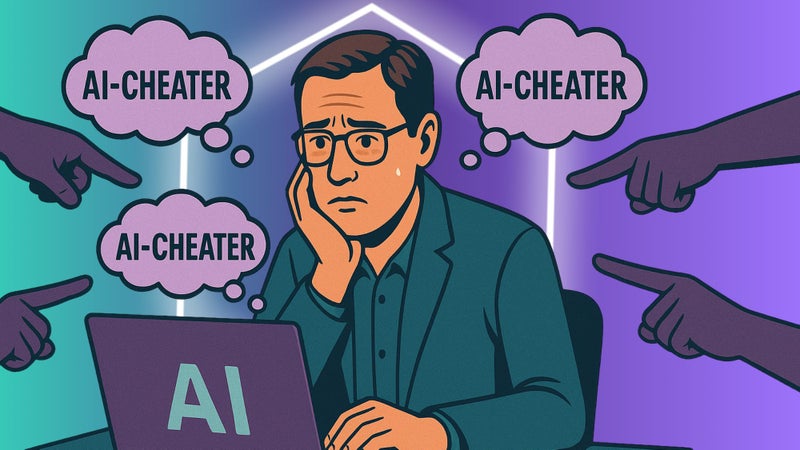Contents
- You're Asking the Wrong Question
- Your 5-Step Framework for Guilt-Free AI
- Don't Throttle Progress Out of Fear
- Is Using AI Cheating? Not if You’re Leading
Is using AI cheating? Traditional 'authenticity' is just inefficient teaching wrapped in moral superiority. Handwriting worksheets doesn't make your content more genuine. The same applies to avoiding AI. But you need to know which lines can and can't be crossed. Master the guardrails, then floor the accelerator.
AI is the degradation of authentic teaching.
That's the fear. But it's WRONG.
The real risk? Blind AI implementation and zero guidance. Two roadblocks leaving AI first teachers paranoid instead of empowered.
You know the feeling.
You've used artificial intelligence (AI) to speed up parent feedback. Generate study guides. Maybe draft a lesson plan or two.
But afterward, you're left with questions.
Are you cutting corners? Being dishonest? Cheating?
Education is changing. But the system isn't keeping up.
- Districts are all-in: 93% have AI in use, with almost half purchasing generative AI tools in the past year
- Teachers are charging forward: More than 60% of U.S. teachers are using AI
- Policies are getting there: Schools allowing AI for classwork nearly doubled - 31% to 60% - in the last year
- Training is missing: Only 6% of teachers get ongoing AI training, with 58% reporting no training at all
Adoption is happening. Policy is adapting. Training is still nonexistent.
And the result is teachers left in the lurch painfully concerned they're doing something wrong.
Still asking the 'is using AI cheating' question? We're here to add color to the grey zone and get you using AI guilt-free.
You're Asking the Wrong Question
Here's the thing.
Using AI to write feedback isn't cheating any more than using Google instead of driving to the library.
The guilt you're feeling is NOT because you're doing something wrong. It's because you aren't clear on the rules you're naturally playing by.
Let's run an experiment.
You use AI to generate discussion questions. Still facilitating the discussion. You draft parent emails with AI help. Still reviewing and personalizing each one.
You let AI grade essays without reading them yourself...
That last one hits differently, right?
That's your teaching expertise naturally doing the important work. Flagging when AI crosses the line from useful support to detrimental outsourcing.
Here's the good news. This is all part of the natural innovation-implementation cycle. Where every level up creates discomfort until we figure out exactly where and how it fits.
Calculators would 'ruin' math skills... until we realized they free students to focus on problem-solving.
Spellcheck would 'degrade' writing... until we understood it lets writers focus on creativity.
Google would make research 'meaningless'... until we learned to focus on evaluation and synthesis skills.
We moved past those fears by understanding the tool and setting the boundaries.
Here's the course correction. Instead of asking 'Is using AI cheating?', ask 'What's the purpose of this task, and how should AI support it?'
Because when you answer that, the guilt disappears.
Your 5-Step Framework for Guilt-Free AI
You've identified the right question. Now you need a system to answer it consistently.
Here's your framework for using AI ethically - without second-guessing every decision.
Step 1: Get AI Fluent
You don't need to become a software engineer. But you do need to understand what you're working with.
Basic functioning. Capabilities. Limitations.
This matters because you can't set smart boundaries around something you don't understand.
Think of it like this. You wouldn't use a new piece of lab equipment without reading the manual. The same principle applies here.
Keep learning how to use AI as it evolves. Keep experimenting. Keep pushing boundaries.
Your fluency needs to grow with the technology.
Step 2: Set Your Non-Negotiables
These are your hardlines. The boundaries that don't shift regardless of how AI develops.
These are fundamentals like student privacy. Data security. Final decision-making.
Vague boundaries create the confusion you're trying to eliminate. So be specific.
Here's a starting point:
- Student data never leaves your secure systems
- AI informs your decisions but never replaces your judgment
- All AI-generated content gets a human review before reaching students
Your non-negotiables are your ethical foundation. Everything else gets built on top.
Step 3: Turn Boundaries Into Policies
Your non-negotiables are principles. Now you need operational policies.
This is where most teachers get stuck. They have gut feelings but don't set clear guidelines.
Lock in policies that guide your actions:
- How you approach using AI for lesson planning and materials
- When and how AI-generated content reaches your students
- Your approach to AI in grading and student support
Written policies eliminate the guilt-inducing guesswork.
Step 4: Map What's Yours vs. What's AI's
Some tasks are perfect for AI. Others need to stay human.
You need to plot your jagged frontier. That ever-shifting border between what AI can handle and what requires your unique human expertise.
AI handles: Data analysis, first drafts, repetitive administration, research compilation.
You handle: Relationship building, emotional support, nuanced judgment calls, creative problem-solving.
Map this out for your specific role. Get clear on exactly who does what and why.
Step 5: Review and Adjust
What you do today isn't set in stone. You NEED regular audits.
Ask yourself: Is this working? Are you teaching better? Are your students benefiting?
Adjust your policies, refine your boundaries, experiment with new approaches.
The goal isn't perfection. It's continuous improvement.
AI is your teaching assistant, not your replacement. But only if you stay in the driver's seat.
Don't Throttle Progress Out of Fear
You're building your guardrails. Now avoid the two extremes that kill AI progress.
Extreme 1: Avoiding AI entirely because it feels wrong.
Extreme 2: Using AI for everything without boundaries.
Both create their issues.
Blacklisting AI doesn't make you more ethical. It makes you less effective and more confused about where the lines actually are.
Using AI recklessly doesn't make you efficient. It makes you sloppy and crosses into genuinely problematic territory.
The sweet spot? Intentional use with clear boundaries.
When you define your why, how, and limits - you remove the guilt and prevent abuse.
You're not cutting corners. You're not being reckless. You're NOT CHEATING.
You're leaning on your hard-earned professional judgment and intentionality to embrace education's inevitable future.
Is Using AI Cheating? Not if You’re Leading
So, is using AI cheating?
Not if you've done the work to use it well.
And you're on the path.
You've set boundaries. Mapped your jagged frontier. Decided exactly who does what.
Your students are set to enter a world where AI is everywhere. They need teachers who understand the world they're moving into and the tools they'll encounter. Not teachers who stick their heads in the sand and pretend this isn't happening.
You need to become an AI-literate leader. And the leadership starts now.
Ready to stop asking 'is using AI cheating' and start modeling what ethical AI use actually looks like? You've got the framework. Your students need the example. Time to lead.








